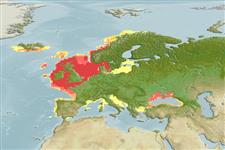Classification / Names
Common names from other countries
Main reference
Size / Weight / Age
Max length : 70.0 cm TL male/unsexed; (Ref. 1371); common length : 23.5 cm TL male/unsexed; (Ref. 1371); max. published weight: 3.1 kg (Ref. 40637); max. reported age: 20 years (Ref. 35388)
Length at first maturity
Lm 27.8, range 28 - 30 cm
Environment
Marine; brackish; benthopelagic; oceanodromous (Ref. 51243); depth range 10 - 200 m (Ref. 1371), usually 30 - 100 m (Ref. 1371)
Climate / Range
Temperate, preferred 11°C (Ref. 107945); 72°N - 35°N, 27°W - 42°E
Distribution
Northeast Atlantic: southeastern Barents Sea and Iceland to Portugal, also in the Black Sea, Aegean Sea, Adriatic Sea and adjacent areas. Rare in the northwestern Mediterranean.
Countries | FAO areas | Ecosystems | Occurrences | Introductions
Short description
Dorsal
spines
(total): 0;
Dorsal
soft rays
(total): 30-40;
Anal
soft rays: 30 - 35. Body elongate; head small. Chin barbel small or absent. Lateral-line canals on head with pores. Color is variable; yellowish-brown, dark blue or green, sides yellowish grey, white and silvery on belly; often with a small dark blotch at the upper base of the pectoral fin.
IUCN Red List Status (Ref. 115185)
Threat to humans
Harmless
Human uses
Fisheries: highly commercial; gamefish: yes; aquarium: public aquariums
Tools
Special reports
Download XML
Internet sources
Estimates of some properties based on models
Phylogenetic diversity index
PD50 = 1.0000 many relatives (e.g. carps) 0.5 - 2.0 few relatives (e.g. lungfishes)
Trophic Level
4.4 ±0.2 se; Based on diet studies.
Resilience
Medium, minimum population doubling time 1.4 - 4.4 years (rm=1.1-1.6(?); K=0.07-0.74; tm=1-4; tmax=20; Fec>100,000)
Vulnerability
Moderate vulnerability (37 of 100)
Price category
